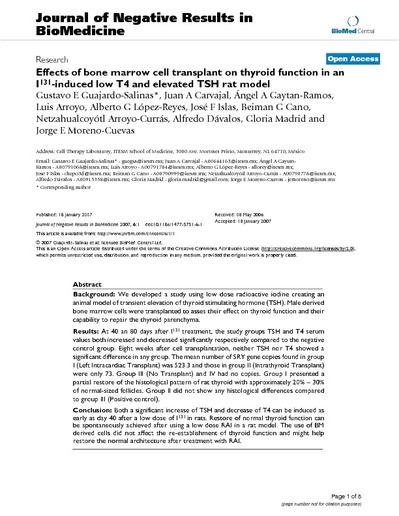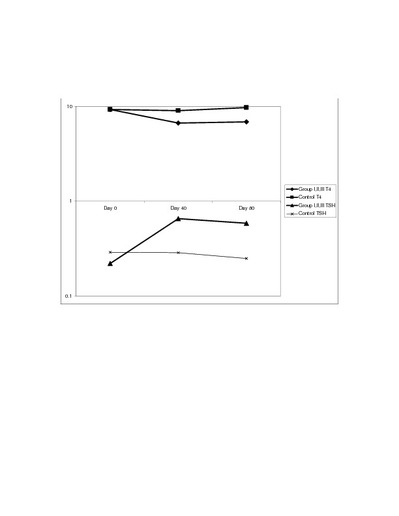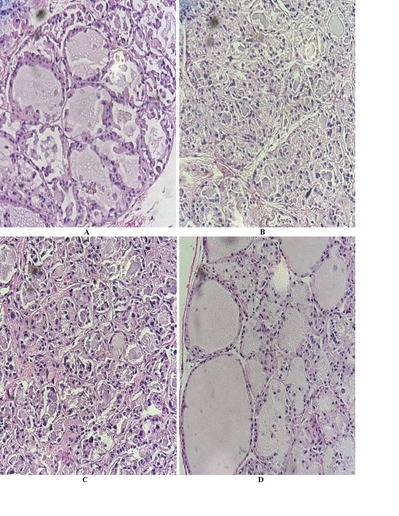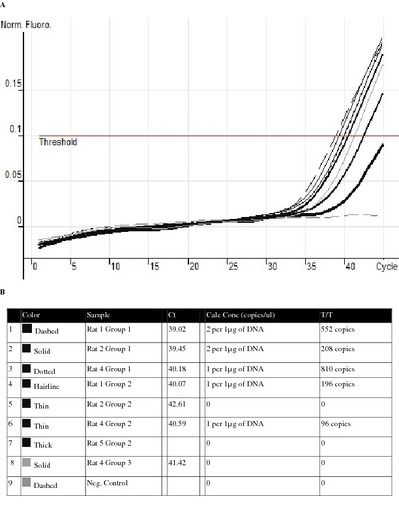Mostrar el registro sencillo del ítem
Effects of bone marrow cell transplant on thyroid function in an I131-induced low T4 and elevated TSH rat model
| dc.contributor.author | Guajardo Salinas, Gustavo E. | en |
| dc.contributor.author | Carvajal, Juan A. | en |
| dc.contributor.author | Gaytan Ramos, Ángel A. | en |
| dc.contributor.author | Arroyo, Luis | en |
| dc.contributor.author | López Reyes, Alberto G. | en |
| dc.contributor.author | Islas, José F. | en |
| dc.contributor.author | Cano, Beiman G. | en |
| dc.contributor.author | Arroyo Currás, Netzahualcoyótl | en |
| dc.contributor.author | Dávalos, Alfredo | en |
| dc.contributor.author | Madrid, Gloria | en |
| dc.contributor.author | Moreno Cuevas, Jorge E. | en |
| dc.date.accessioned | 2016-06-20T02:27:29Z | |
| dc.date.available | 2016-06-20T02:27:29Z | |
| dc.date.issued | 18/01/2007 | |
| dc.identifier.other | Journal of Negative Results in BioMedicine. 2007 Jan 18;6(1):1 | |
| dc.identifier.uri | http://dx.doi.org/10.1186/1477-5751-6-1 | |
| dc.identifier.uri | http://hdl.handle.net/11285/613677 | |
| dc.description.abstract | Abstract Background We developed a study using low dose radioactive iodine creating an animal model of transient elevation of thyroid stimulating hormone (TSH). Male derived bone marrow cells were transplanted to asses their effect on thyroid function and their capability to repair the thyroid parenchyma. Results At 40 an 80 days after I131 treatment, the study groups TSH and T4 serum values both increased and decreased significantly respectively compared to the negative control group. Eight weeks after cell transplantation, neither TSH nor T4 showed a significant difference in any group. The mean number of SRY gene copies found in group I (Left Intracardiac Transplant) was 523.3 and those in group II (Intrathyroid Transplant) were only 73. Group III (No Transplant) and IV had no copies. Group I presented a partial restore of the histological pattern of rat thyroid with approximately 20% – 30% of normal-sized follicles. Group II did not show any histological differences compared to group III (Positive control). Conclusion Both a significant increase of TSH and decrease of T4 can be induced as early as day 40 after a low dose of I131 in rats. Restore of normal thyroid function can be spontaneously achieved after using a low dose RAI in a rat model. The use of BM derived cells did not affect the re-establishment of thyroid function and might help restore the normal architecture after treatment with RAI. | |
| dc.language.iso | eng | en |
| dc.publisher | Open Access Publisher | en |
| dc.relation.url | http://jnrbm.biomedcentral.com/articles/10.1186/1477-5751-6-1 | en |
| dc.rights.uri | http://creativecommons.org/licenses/by-nc-nd/4.0/ | * |
| dc.title | Effects of bone marrow cell transplant on thyroid function in an I131-induced low T4 and elevated TSH rat model | en |
| dc.type | Artículo / Article | en |
| dc.contributor.department | Tecnologico de Monterrey | en |
| dc.rights.holder | Guajardo-Salinas et al; licensee BioMed Central Ltd. | |
| dc.date.updated | 2016-06-01T12:18:54Z | |
| dc.subject.discipline | Ciencias de la Salud / Health Sciences | |
| refterms.dateFOA | 2018-03-24T08:33:33Z | |
| html.description.abstract | Abstract Background We developed a study using low dose radioactive iodine creating an animal model of transient elevation of thyroid stimulating hormone (TSH). Male derived bone marrow cells were transplanted to asses their effect on thyroid function and their capability to repair the thyroid parenchyma. Results At 40 an 80 days after I131 treatment, the study groups TSH and T4 serum values both increased and decreased significantly respectively compared to the negative control group. Eight weeks after cell transplantation, neither TSH nor T4 showed a significant difference in any group. The mean number of SRY gene copies found in group I (Left Intracardiac Transplant) was 523.3 and those in group II (Intrathyroid Transplant) were only 73. Group III (No Transplant) and IV had no copies. Group I presented a partial restore of the histological pattern of rat thyroid with approximately 20% – 30% of normal-sized follicles. Group II did not show any histological differences compared to group III (Positive control). Conclusion Both a significant increase of TSH and decrease of T4 can be induced as early as day 40 after a low dose of I131 in rats. Restore of normal thyroid function can be spontaneously achieved after using a low dose RAI in a rat model. The use of BM derived cells did not affect the re-establishment of thyroid function and might help restore the normal architecture after treatment with RAI. |
Ficheros en el ítem
Este ítem aparece en la(s) siguiente(s) colección(ones)
-
Artículo 1151
Article





